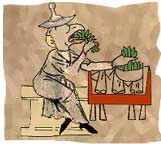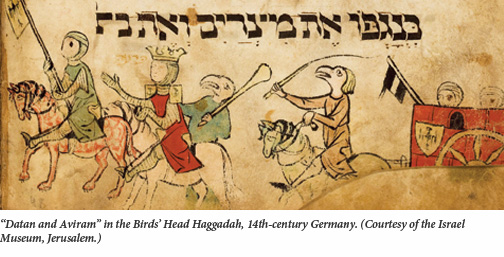The Birds' Head Haggadah, the oldest surviving Ashkenazi illuminated manuscript (S. German, c. 1300), derives its name from the birdlike human figures illustrated in the manuscript's margins. This motif is apparently related to the biblical (Second Commandment) prohibition against creating graven images. In the Birds' Head Haggadah, discovered by Jewish art historian Bezalel Narkiss in 1946, the realistic human figure is avoided by providing it with the head and beak of a bird, but also by distorting or hiding it — with helmets, bulbous noses, and blank faces.Some of the pictures are really interesting (even without the birdshead element) - look at this picture for example:
You can see that women were part of the making team, wore head coverings (though short shirts) and that one of the men is without any head covering. Also they appear to be holding an intrument that looks like a fork - presumably to make holes in the Matzah (forks not being around for a few centuries yet).
People have long speculated about the choice of drawing everyone as Birdheads. In a recent column in the Jewish Review of Books, Michel Stein (Who also just published a book The Medieval Haggadah: Art, Narrative, and Religious Imagination
In the Birds' Head Haggadah, almost all adult male Jews, including Abraham, Jacob, Moses, Aaron, the Israelite elders, and the leader of the Seder, are depicted as wearing the Judenhut. But there are three instances in which individuals with griffin heads are shown bareheaded. The first two are pictures of Joseph and the Israelite slaves. Rabbinic tradition is very careful to represent Joseph as remaining a tzaddik—a Jewish saint—even while working for Pharaoh. Similarly, the Israelites are understood to have remained uncompromisingly traditional, even while enslaved in Egypt—refusing to change their language, their clothing, or their Hebrew names. Given that the midrash explicitly affirms that the Jews continued to wear their distinctive clothing, the denial of the Jewish hat to these figures seems strange.
In fact, I believe this depiction to be a deliberate critique of the rabbinic tradition growing out of the actual experience of medieval Jews in Ashkenaz. One figure of medieval Jewish life was the Jew who worked in the royal court, or for local princelings, in some capacity. Although these individuals often played a key role in the safety and well being of their communities, their everyday lives at court placed inevitable strains on religious observance, as well as raising suspicions among fellow Jews regarding their true loyalties. I suspect that the image of Joseph and the slaves as Jews without hats is evidence of a real-world skepticism that, rabbinic assurances notwithstanding, Jews could ever have remained fully observant at court.
He continues:
The third instance of hatless griffin-headed Jews is one I would have missed if it weren't for another one of my children. When he was about 10, my son Misha and I were looking at the elegant 1965 facsimile of the Birds' Head Haggadah. Seeing that Pharaoh and his soldiers, who are shown pursuing the departing Israelites, are depicted with blank human heads, he remarked that "all the mitzrim (Egyptians) have normal faces, and all the Bnei Yisrael (Jews) have birds' faces." Smug, in what I supposed was my superior art-historical expertise, I replied, "Look again, Misha—and this time more carefully—do all the mitzrim really have normal faces? Can you spot the two who don't?" The child did not miss a beat. "Abba," he burst out, "anybody can tell that those guys are Datan and Aviram!" In response to my puzzled look, he explained, "The nogshim (Jewish taskmasters)! See? One of them has a whip and the other has a club, so they have to be Datan and Aviram!"
Epstein takes this point a little far - as a " a recognition on the part of Ashkenazic patrons and their artists that rabbinic tradition might have "protested too much" about the piety of some biblical figures." You could just as easily argue that this is just a way of showing that not all the Jews left Egypt (though they do seem to have weapons - implying that they are part of the army).



No comments:
Post a Comment